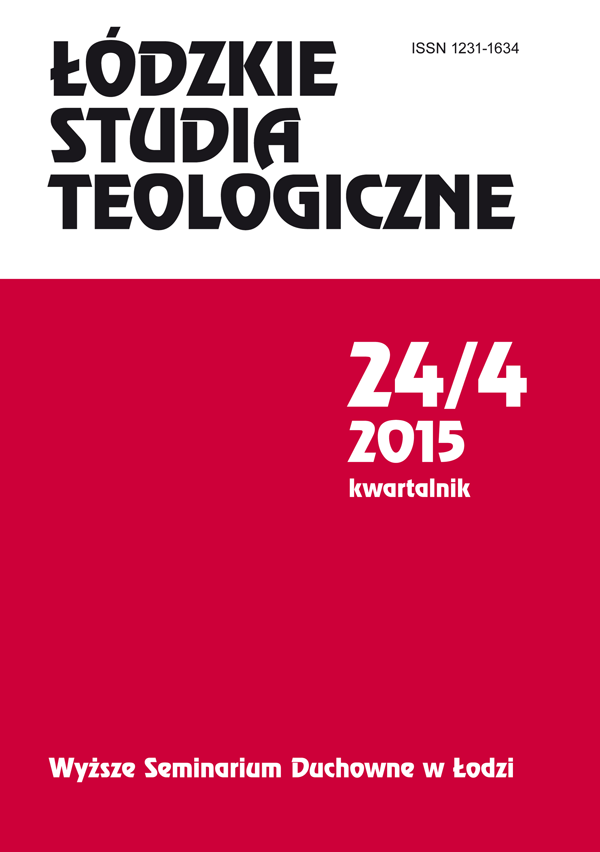Pojęcie miłosierdzia w dzienniczku św. Faustyny Kowalskiej
The concept of mercy in the “Diary” by saint Faustina Kowalska
Author(s): Izabela RutkowskaSubject(s): Lexis, Semantics, Philosophy of Religion, Biblical studies, Hermeneutics, Sociology of Religion
Published by: Wyższe Seminarium Duchowne w Łodzi
Keywords: lexeme “mercy” in the “Diary” by saint Faustina; image of mercy; worshipping the Divine Mercy; semantic transgressions; religious text; mystical texts;
Summary/Abstract: All the contexts of the usage of the lexeme “mercy” in the “Diary” by saint Faustina give it a new semantic field and they stretch the term “mercy” onto all types of God’s activity – from the creation of the world to the salvation of mankind. It shows that the author anticipated the intuitions of the Second Vatican Council and contemporary research on this Christian notion, which has not been fully presented and understood yet. For theologians many phrases can be clear evidence that the massage of this text must have come from the revelation, for example such expressions as “depths of tenderness”, “the bosom of the Father”. For a theologian and biblical scholar it is a clear reference to Hebrew rahamīm, about which Faustina could not know. The expression “the bosom of the Father” is rarely used in religious texts even mystical ones.The image of mercy and attitudes one can adopt in relation to it point out mainly to one notion – worshipping the Divine Mercy. This image is proven by the research of key words – they focus on the priority of worshipping over other attitudes, even over the attitude of trust which is so often mentioned. Semantic transgressions can be noticed in the texts – shifts of the meaning, which are a particular characteristic of mystical writings. In this research those shifts refer to a semantic field of a lexeme “worship”. They also show that phrases describing a relationship of “mercy” “man – man” where included to a semantic field describing the relationship “man – God” and they mainly refer to the semantic scope of a lexeme “mercy”. The “Diary” clearly breaks with a common dictionary-based negative image of a situation of humiliating inequality which could be generated by showing mercy. According to Faustina’s text lowering of God to man and, similarly, of man to another man is aimed at making those people and their positions equal, entering into deep mutual participation and experiencing the same situation. Thus, showing mercy does not create a chasm between the giver and recipient but it annuls it. Such a wide semantic field exceeds a stereotypical (or prototypical) Christian image of mercy, which is mostly limited to a model of the merciful Samaritan or the father of a prodigal son, of Caritas foundation or religious orders which help the sick and the poor. According to the “Diary” every God’s activity demonstrates mercy, every action of Jesus as presented in the gospels, every healing, every meeting with people (with Nicodemus, Mary Magdalene, with a young man from Nain), a selection of disciples and the sermon on the mountain. We should include there a description of the creation of the world, events with the Babel tower and the flood. However if we made a survey and presented three images: of Christmas, of the Samaritan leaning over a dying man on the way from Jericho and the scene of Resurrection and if we asked which picture illustrated the Divine Mercy, people would most often point out the second image. For Faustina, however, there is no greater manifestation of mercy than the incarnation and resurrection. The issue of sacraments is treated in a similar way. The “Diary” points out that one should not look for the elements of mercy in the Eucharist but that the whole Eucharist should be interpreted as a gift of the Divine Mercy. It cannot be said, for example, that confession is more the image of mercy that baptism, confirmation or Eucharist. Undoubtedly, it can be perceived in this way due to existing stereotypes. This research, though it seems vast, is only an introduction to a more detailed analysis (hence a note at the title – part 1)
Journal: Łódzkie Studia Teologiczne
- Issue Year: 24/2015
- Issue No: 4
- Page Range: 71-89
- Page Count: 19
- Language: Polish

